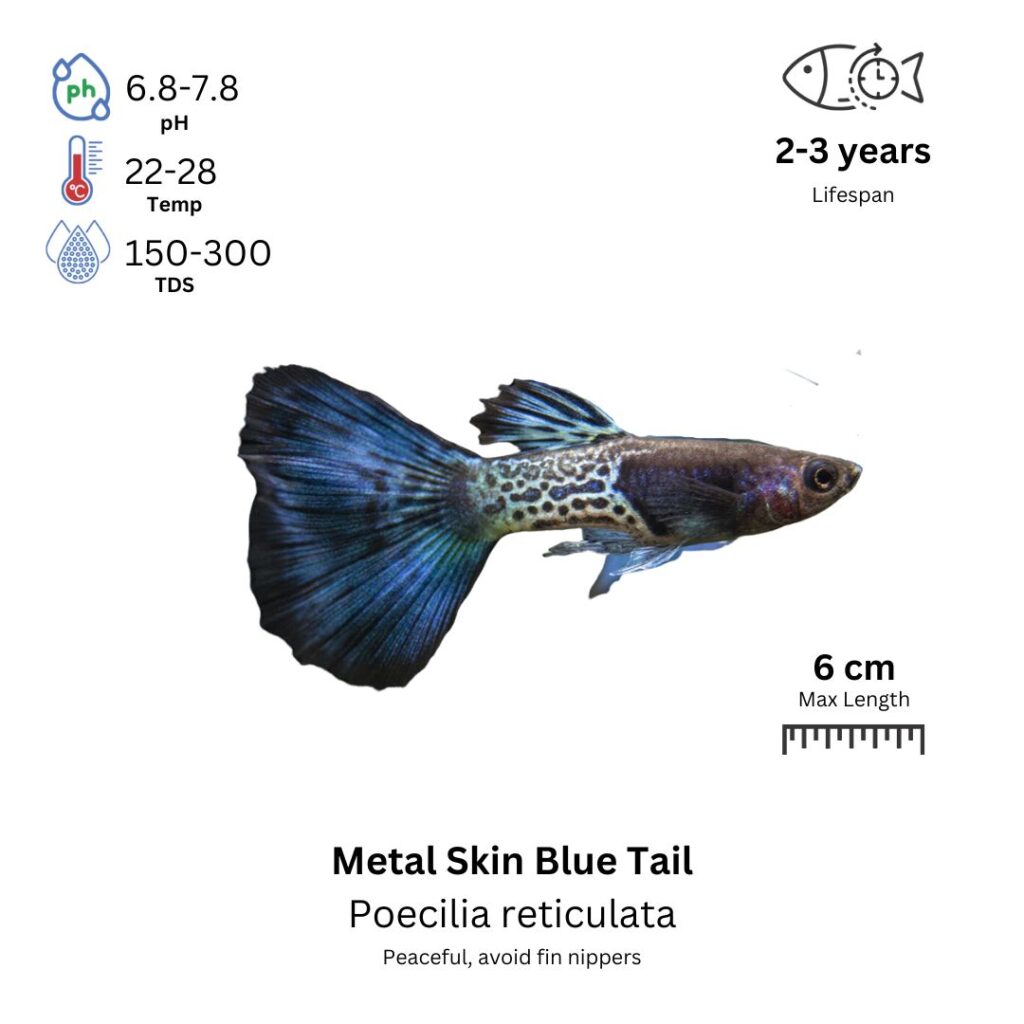Metal Skin Blue Tail
Pterophyllum scalare

Description
The Metal Skin Blue Tail is a captivating and peaceful species of freshwater fish known for its brilliant and iridescent coloration. This species is part of the rainbowfish family and exhibits a unique metallic sheen on its body, which gives it the “metal skin” appearance. The body of the fish is typically a pale to silvery blue, with a striking iridescent finish that reflects light in a beautiful manner. Its tail is often a vivid blue, which contrasts with the body and further adds to its vibrant look. The blue tail is one of the most distinguishing features of this fish, making it an attractive and eye-catching addition to any aquarium.
Habitat Origin
Native to the freshwater streams and rivers of Papua New Guinea and parts of northern Australia. They are found in slow-moving waters with clear, oxygen-rich conditions. These fish thrive in shallow areas with plenty of submerged plants, rocks, and other structures that provide shelter. In the wild, they tend to live in regions with soft, slightly acidic to neutral water.
Aquarium
Ideal Number in Aquarium: Best kept in groups of at least 6-8 individuals to allow for schooling behavior. Larger groups are preferred for their social nature.
Favorite Food

The Metal Skin Blue Tail is omnivorous and will accept a variety of foods. They can be fed high-quality flake food, micro pellets, and live or frozen foods such as brine shrimp, daphnia, and bloodworms. They will also enjoy small vegetable-based foods, like spirulina, blanched zucchini, and lettuce. Providing a varied diet ensures that they remain healthy and vibrant, maintaining their beautiful metallic sheen.
Behavior:
Metal Skin Blue Tails are peaceful and active fish that thrive in groups. They are often seen swimming in schools, which is one of the reasons why they are such an interesting species to keep. Their active nature and small size make them perfect for community tanks with other peaceful species. They are not territorial and do not display aggression toward other fish. However, they may become more active and display courtship behavior during breeding.
Special Care:
Metal Skin Blue Tails are relatively easy to care for, but they do need stable water conditions. Regular water changes, good filtration, and a well-maintained tank are essential for keeping them healthy. These fish prefer tanks with plenty of plants and hiding spots, as well as open swimming areas. The substrate should be soft, as they tend to spend a lot of time near the bottom of the tank foraging. Additionally, they enjoy well-oxygenated water, so good water movement is important.
Compatibility with Other Fish:
The Metal Skin Blue Tail is compatible with a wide variety of peaceful fish species. They are best kept with other small, non-aggressive fish such as tetras, rasboras, corydoras catfish, and shrimp. They are also ideal tankmates for other peaceful rainbowfish. Larger or more aggressive fish should be avoided, as they may stress out the Metal Skin Blue Tails. It’s important to keep them in a peaceful community tank, as their small size and peaceful nature make them vulnerable to bullying.
Breeding Setup
Although not absolutely necessary, a separate breeding tank is highly recommended for Metal Skin Blue Tail Swordtails. These active livebearers may show territorial behavior during breeding, and a dedicated tank helps prevent disturbances from other fish. A tank size of 40–60 liters (10–15 gallons) is sufficient, providing space for the breeding pair and their future fry. Maintain water conditions at pH 7.0–8.0, temperature 24–28°C, and hardness around 6–12 dGH. Use a sponge filter or low-flow internal filter to ensure clean water without generating strong currents. A fine gravel or sand substrate combined with Java moss, Anubias, or smooth rocks provides ideal spawning and hiding spots. Lighting should follow a 10–12 hour daily cycle, with shaded areas to reduce stress, especially for the female.
Conditioning for Breeding
To prepare Metal Skin Blue Tail Swordtails for breeding, offer a high-quality, protein-rich diet. Feed them live or frozen foods such as brine shrimp, daphnia, and bloodworms, along with premium flakes or pellets suited for livebearers. This nutritional boost helps the female produce healthy fry and energizes the male for active courtship. Regular partial water changes (20–30%) are essential to maintain water quality. Slightly increasing the temperature to around 28°C can also act as a natural trigger for spawning behavior.
Spawning Process
Swordtails are livebearers, meaning they give birth to live fry rather than laying eggs. Once conditions are right and the female is fertilized, she will carry the developing fry for about 4–6 weeks. During this time, the male may continue courting or guarding his territory. A healthy female can produce 20 to 100 fry per spawning, depending on her size and condition. After birth, it’s not strictly necessary to separate the parents, but it is wise to provide ample hiding places for the fry to avoid predation by adults.
Fry Development & Care
Fry are fully formed at birth and begin swimming immediately. Initially, feed them infusoria, liquid fry food, or finely crushed flakes. After 5–7 days, you can begin introducing newly hatched brine shrimp or microworms to support rapid growth. Maintain excellent water quality with small, regular water changes (10–15% every 2–3 days) and ensure gentle filtration using a sponge filter. Keep the temperature stable between 24–28°C, and avoid strong currents. Plants and decor will offer safety and reduce stress during early development.
Key Considerations & Stress Prevention
Swordtails typically reach breeding maturity at 4–6 months. Males are recognizable by their sword-like tail extension and more vibrant coloration, while females are larger, rounder, and often more subdued in color. To prevent stress and improve breeding success, avoid overcrowding, maintain stable water parameters, and remove aggressive tankmates. Consistent care and a calm environment are crucial to ensuring a healthy breeding cycle and high fry survival rate.
